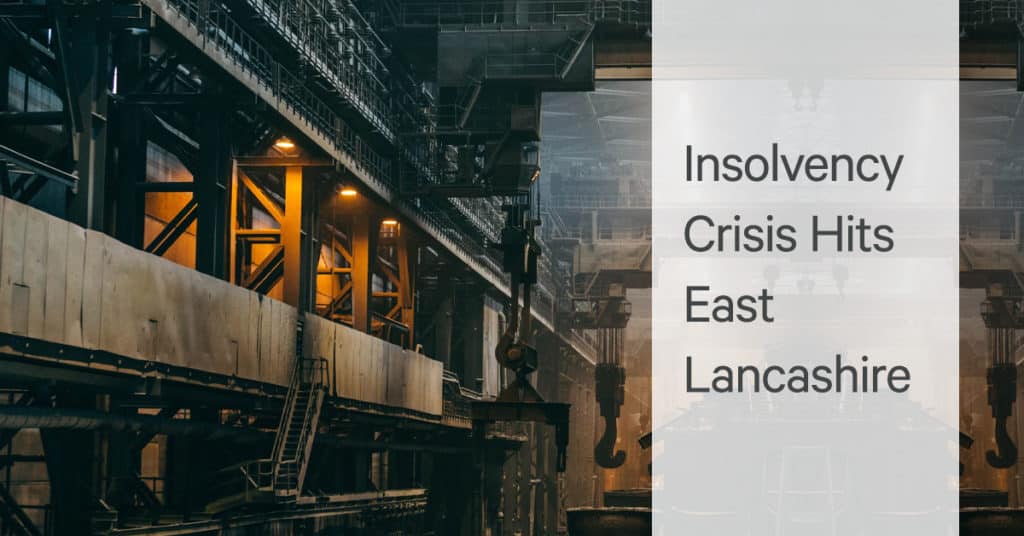East Lancashire is facing an insolvency crisis, with the number of businesses going bust in the region rising sharply in recent years.
The changing business landscape of East Lancashire
East Lancashire has a long industrial history, dating back to the Industrial Revolution. The region once had a thriving textile industry, which employed thousands of people. However, the textile industry declined in the latter half of the 20th century, and many jobs were lost.
In recent years, East Lancashire has seen a shift towards a more diversified economy. The region is now home to several different industries, including manufacturing, engineering, and healthcare, alongside a growing service sector.
The typical economic landscape of East Lancashire is one of mixed prosperity. Some areas are doing well, while others are struggling. However, in recent years the region has seen a spike in the unemployment rate, and many people are now struggling and living in poverty.
What the numbers say
According to a new analysis of business insolvencies, the number of firms going into liquidation annually in East Lancashire has increased by 91% between 2019 and 2022 with a total of 1,651 businesses being liquidated. This is the second highest increase in England, after the North-West as a whole, where insolvencies have risen by 78%.
The crisis is particularly acute in Burnley, where the number of businesses going bust has quadrupled over the same period. In 2019, just 48 firms went into liquidation in Burnley. By 2022, this number had risen to 201.
Why is insolvency on the increase?
The reasons for the insolvency crisis in East Lancashire are complex. However, a few factors are likely to be contributing, including:
- The COVID-19 pandemic has had a devastating impact on many businesses.
- The rising cost of living is putting pressure on household budgets and businesses’ bottom lines.
- The ongoing uncertainty surrounding Brexit has made it difficult for businesses to plan for the future.
In addition to the factors mentioned above, there are several other challenges that businesses in East Lancashire are facing. These include:
- The decline of traditional industries, such as coal mining and textiles.
- The lack of investment in infrastructure and skills.
- The competition from businesses in other parts of the country and the world.
The decline of traditional industries, such as coal mining and textiles in East Lancashire, has had a profound impact on the region. These industries were once the backbone of the local economy, providing jobs and prosperity for generations. However, in recent decades, they have faced increasing competition from cheaper imports and new technologies. As a result, many factories have closed, and thousands of jobs have been lost.
There are a number of factors that have contributed to the decline of traditional industries in East Lancashire. One factor is the globalisation of the economy. As the world has become more interconnected, it has become easier for businesses to move production to countries where labour is cheaper. This has put pressure on traditional industries in developed countries, such as East Lancashire, where wages are higher.
Another factor that has contributed to the decline of traditional industries is technological change. New technologies have made it possible to produce goods more efficiently, which has led to a decrease in demand for labour. This has been particularly true in the textile industry, where new machines have been able to replace many of the manual tasks that were once done by workers.
These challenges make it difficult for businesses in East Lancashire to compete and thrive. As a result, many businesses are forced to close, further contributing to the insolvency crisis and its impact on the East Lancashire economy. Businesses that go bust lay off staff, which can lead to job losses and economic hardship. The crisis also has a knock-on effect on other businesses in the region, as they lose customers and suppliers in their service chain.
What can be done to address the insolvency crisis?
The insolvency crisis is a serious problem for East Lancashire. However, several things can be done to address it. These include:
- Providing financial support to businesses that are struggling.
- Reducing the cost of living to help businesses and households make ends meet.
- Investing in infrastructure and skills.
- Creating a more supportive environment for businesses.
- Raising awareness of the challenges facing businesses in East Lancashire.
- Providing certainty about Brexit so businesses can plan for the future.
There is no easy solution to the problems facing East Lancashire. However, there are a number of things that can be done to help the region. One important step is to invest in education and training, so that people have the skills they need to find new jobs. Another important step is to attract new businesses to the region, so that people can find work locally.
Here to help
Insolvency can be a difficult and stressful experience. If you are facing insolvency, seeking professional advice can help you to understand your options and put a plan of action in place.
At Simple Liquidation, our team of experts will sit down with you to understand your situation and assess the best course of action. Do not hesitate to contact us if you need more information, have any questions, or would like to speak to one of our experts.




